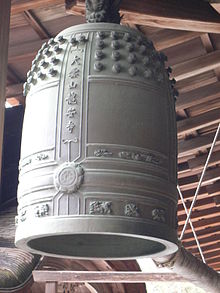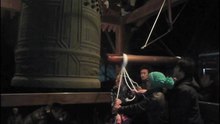Bonshō

Bonshō ( Japanese 梵 鐘 , "Buddhist bell"), also known as tsurigane ( 釣 鐘 , "hanging bell"), ōgane ( 大 鐘 , "big bell"), geishō ( 鯨 鐘 ) and kōshō ( 洪鐘 , both "giant bell ") , are usually 1.50–2 m high temple bells with 60–90 cm diameter in Buddhist monasteries in Japan , which call the monks to prayer and indicate the time of day. They do not have a clapper, but are struck from the outside on a reinforced area called tsukiza ( 撞 座 , "beating base") with a wooden beam ( 撞 木 , shumoku , " beating block ") hanging on ropes.
The bells are usually cast from bronze, less often from iron. They are often decorated with raised patterns and inscriptions. The earliest bells are dated to around AD 600. They go back to older Chinese models. The piercing sound of the bells carries over great distances, which is why they were also used for signals, time indications and emergency calls. In addition, the bell sound was assigned supernatural properties, for example that it could be heard in the underworld Diyu / Jigoku. The spiritual meaning of the bonshō plays a large role in Buddhist ceremonies such as the Japanese New Year celebrations and the Bon festival.
By the Japanese history, stories and legends draw these bells, including fictitious as the Benkei bell of Mii-dera , and historical, as the bell of Hoko-ji. The classic Heike Monogatari ("Stories of the Heike") from the 14th century begin and end with the solemn sound of a bell, which symbolizes the inseparability of life, death and time.
In recent times the bells have become a symbol of world peace . In 1954, Japan presented the United Nations in New York with a peace bell as a symbol of world peace. It had been cast from metal obtained from donated coins and medals from all over the world. Similar bells, which represent the endeavor for world peace, can be found, for example, in the Hiroshima Peace Park .
literature
- Henry Johnson: Bonshō. In: Grove Music Online, January 13, 2015
Individual evidence
- ↑ 梵 鐘 . In: 日本 大 百科全書 at kotobank.jp. Retrieved December 20, 2015 (Japanese).
- ↑ a b Harada Kazuyoshi: New Bells with an Age-old Sound: Oigo Seisakusho. In: www.nippon.com. Nippon Communications Foundation, October 7, 2013, accessed September 2, 2014 .
- ↑ Steven Henry Gill, Julian May: Heart & Soul: Japan's Buddhist temple bells. In: www.bbc.co.uk. BBC World Service, March 7, 2010, accessed December 14, 2015 .
- ^ William P. Malm: Traditional Japanese Music and Musical Instruments: The New Edition . Kodansha International, 2000, ISBN 978-4-7700-2395-7 , pp. 74 .
- ↑ Japanese Peace Bell . In: UN Tour . United Nations. Accessed May 2013.
- ^ Alvin M. Weinberg: Chapters from the Life of a Technological Fixer . In: Minerva , December 1993, pp. 447-448. Retrieved May 10, 2013.

